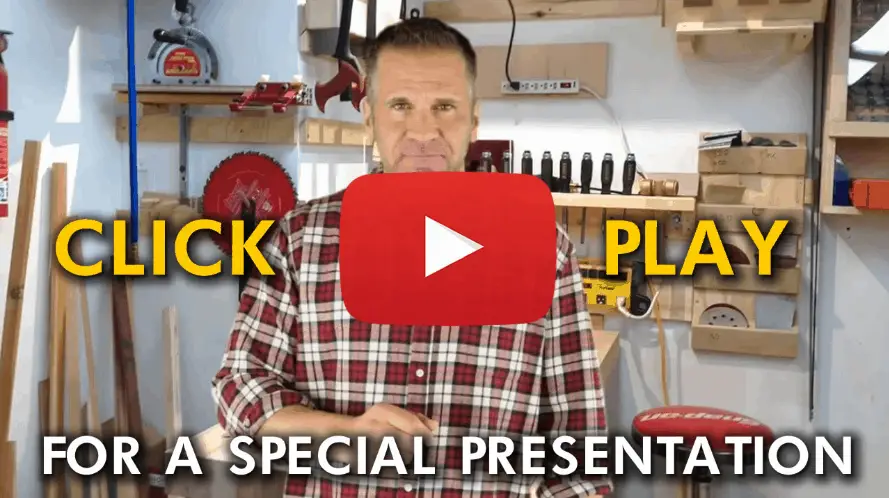Subscribe to The Honest Carpenter on YouTube
Table saws are powerful tools that can make woodworking much easier, but they can also be very dangerous if not used correctly. In this article, the worst table saw mistakes that can be made will be discussed, along with tips on proper usage. Mistakes will be listed in order of importance, starting with those that may not be as obvious and finishing with more common mistakes.
Key Takeaways
- Always use a push stick for rip widths under a foot.
- Never cut freehand; always use the fence or a miter gauge.
- Avoid squeezing the cut around the blade; use only light force from the outside hand towards the fence.
Mistake: Twisting the Board
Twisting the board is considered a cardinal sin when working with any spinning blade, including a table saw. Despite the table saw’s highly effective fence, which guides the board on a straight path and limits friction on the blade, problems can still occur if the board gets twisted away from the fence. This can cause friction to increase against the rigid blade, causing the motor to bog down. If friction builds up too much, the blade may bind, throwing the board back towards the operator like a catapult launching, which is very dangerous.
To avoid this mistake, it is crucial to use the fence and keep the board moving in a straight line. Beginners and even sometimes pros can run into problems with this, such as not having the inside edge fully flush with the fence at the start and beginning to drive at an angle without realizing it. This will leave slack at the fence, and if they swing the board to compensate, it may cause the blade to bind. They may also be using a board with a ragged edge against the fence, creating gaps that can make the board wiggle enough to cause the blade to bind. Therefore, it is essential to use the fence and ensure that the board has a clean, straight edge to push against the fence.
Mistake: Cutting Freehand
Cutting freehand is a common mistake that many people make when using a table saw. This involves pushing the stock into the blade under hand guidance alone, without using the fence or a miter gauge. However, this is a terrible idea as it creates many opportunities for twisting the blade.
Guiding a board straight in by hand is not easy and it catches friction on the table. The hands may fight each other for control, and it gets harder as the remaining stock gets thinner. In the end, a seesaw effect between the hands may cause the board to twist and the blade to bind.
To avoid this mistake, it is essential to use the fence or a miter gauge. This makes the cut cleaner, safer, and more effective.
Want To Improve Your Woodworking?
Discover 1,000 Hours Of Step-By-Step Woodworking Videos

It’s called Woodwork101. A database of detailed videos and blueprints in crystal clear, mouth-watering HD that will take you by the hand and show you that DIY home projects done the right way are easy, fun, and always of top quality… turning dream into reality in a heart-beat. Getting you that perfect build each and every time.
Mistake: Squeezing the Cut
When using a table saw, it is important to avoid squeezing the cut around the blade. Even when using a fence, this mistake can occur. One common reason for this mistake is applying too much force with the outside hand. Beginners may try to guide their stock by pushing it forward with one hand and pushing it towards the fence really hard with the other hand. This may seem more secure to them, but it’s actually overcompensating.
One’s hand should never be very far forward on the stock. It should always be well on your side of the blade. This is because it can create too much sideways pressure. As the blade passes deeper into the stock, the board loses rigidity. Too much outside side pressure may squeeze the off-cut onto the blade, causing it to pinch the blade and bind. Therefore, it’s essential to keep both hands pushing forward but use only very light force from the outside hand towards the fence. The inside hand should be the dominant force, with the outside hand just helping it keep on track. This will also keep one from twisting the board, which is just as likely with this bad technique.
Mistake: Ripping Boards Wider than They Are Long
One of the most common mistakes people make when using a table saw is ripping boards that are wider than they are long. Table saws are designed to make long straight rips, and while they can be used for cross cutting, it can be more difficult to do so safely.
When a beginner has a board that is shaped in a way that they want to make a cut across the narrow dimension, they may dial the fence to the right width and start going through the cut procedure. However, this sideways shape is very unstable going through a table saw as it is only supported at one end. It can be difficult to keep the narrow edge pinned against the fence, and the long offcut will act like an anchor, pulling the piece diagonally.
As a result, people may overcompensate by pushing that end forward, which can cause the seesawing effect between the two hands. Both twisting and blade squeezing are likely, making it a very unstable way to cut on the table saw.
If a person needs to cut a shape like this, they may want to consider using a circular saw or miter saw instead. Alternatively, they could make a cross-cut jig for their table saw. However, they should be wary of cutting like this on the fence.
[Video] 3 Most Common Mistakes
When Setting Up Shop

A woodworking friend of mine shared this video by Ralph Chapman with me that helped him set up his workshop.
The video explains the benefits of Ralph Chapman’s guide about setting up an affordable workshop and avoiding the most common mistakes offers to anyone interested in woodworking.
Mistake: Levering
Levering is a mistake that occurs when a board is not kept flat on the table saw while making a cut. This mistake is fairly innocent but still one to be avoided. It’s very easy to do this at the start, especially if the piece is long or heavy. The weight of the back can tip the front up like a lever, and the user may begin feeding it into the blade while it’s off the table surface. This is dangerous because the wood might then lower suddenly onto the blade, causing a lot of friction and then kickback.
To avoid this mistake, the user should make sure to keep the front of the stock flat on the table. They should give it a little up and down wiggle to feel for flush contact, pin it down lightly with the finger, then slowly drive forward to initiate the cut. The surface stability is needed all the way through the cut.
Mistake: Failure to Catch the Outfeed
Failure to catch the outfeed is a mistake that occurs when the far end of the board, which has passed over the blade and is exiting the back of the tool, is not supported. As more stock passes over, the weight of that end increases, pulling it downward and levering the end of the board upward. This can pull the board off the blade and table, making it dangerous for the operator.
To avoid this mistake, it is important to support the outfeed. This can be done by having a second person be there to gently catch it from behind or creating a platform that the outfeed can rest on. If cutting something long or heavy, be sure to have support back there.
Mistake: Pulling Small Pieces from the Back
Pulling small pieces from the back of the saw can be very dangerous. It is tempting to go around to the back side of the saw and pull pieces through from that side, but this can lead to injury. You should never grab the far side of a piece with your hand anywhere near the blade.
The outfeed refers to the far end of the board that has passed over the blade and is exiting the back of the tool. The end of the board no longer has the full support of the table, so as more stock passes over, the weight of that end increases, pulling it downward. As a result, the end of the board gets levered upward, pulling it off the blade and table. This is really dangerous because it’s possibly going to try to pull you forward towards the blade as you try to control the piece.
To avoid this mistake, you should support your outfeed. Have a second person be there to gently catch it from behind or create a platform that the outfeed can rest on. If you’re cutting something long or heavy, just be sure to have support back there.
Mistake: Dropcutting
Dropcutting is a dangerous practice that should be avoided when using a table saw. It involves cutting a board without using the fence or miter gauge to guide the cut. Instead, the operator holds the board with their hands and drops it onto the blade, hoping to make a straight cut.
This technique is extremely unsafe because it creates many opportunities for the blade to twist and bind. It’s not easy to guide a board straight in by hand, and it catches friction on the table. Your hands may fight each other for control, and it all gets harder as your remaining stock gets thinner. In the end, you might create a seesaw effect between your hands, and the board will twist, and the blade will bind.
To avoid dropcutting, always use the fence or miter gauge to guide the cut. It makes everything about the cut cleaner, safer, and more effective.
[Guide] How To Launch Your Woodworking Business For Under $1000
Click Here To View
If you’re considering turning your woodworking hobby into a part-time business check out this helpful guide on how to get started.
Mistake: Reaching Over The Saw
Reaching over the saw is a common mistake that can lead to serious injuries. It involves leaning over the saw blade to reach for something on the other side of the saw, such as a piece of wood or a tool. This can cause the operator to lose balance and fall onto the blade, resulting in severe cuts or amputations.
To avoid this mistake, the operator should always keep a clear workspace around the saw and never reach over the blade. Instead, they should turn off the saw and wait for the blade to come to a complete stop before retrieving any objects on the other side of the saw. Additionally, the operator should always wear appropriate personal protective equipment, such as safety glasses and gloves, to minimize the risk of injury.
Mistake: Ripping Narrow Widths
Ripping narrow widths on a table saw can be a challenge for beginners. While table saws are designed to make long straight rips, it can be risky to cut boards that are wider than they are long. This is because the sideways shape of the board is very unstable going through the saw and is only supported at one end. As a result, beginners may have a hard time keeping the narrow edge of the board pinned against the fence, causing the board to twist and the blade to bind.
To avoid this mistake, it is recommended to use a circular saw or miter saw instead of a table saw when cutting narrow widths. If a table saw is the only option, a cross-cut jig can be made to provide more stability during the cut. However, it is important to be wary of cutting like this on the fence to prevent accidents from happening.
Mistake: Standing Directly Behind Your Stock Wood
When operating a table saw, it is important to avoid standing directly behind your stock wood. This mistake can lead to serious injury, as the wood may kick back towards the operator, potentially causing harm.
To avoid this mistake, it is recommended to stand to the side of the saw blade, at a safe distance from the stock wood. This will ensure that any kickback is directed away from the operator. Additionally, it is important to use proper safety equipment, such as safety glasses and hearing protection, when operating a table saw.
By following these guidelines and avoiding the mistake of standing directly behind your stock wood, you can ensure a safer and more effective woodworking experience.



